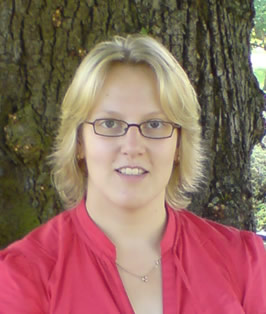Katharina Müller-Ott
Research Interest
All processes that access the DNA information in the cell nucleus, like DNA replication and repair, gene transcription and recombination, depend on an efficient transport of molecules to their target sites. Describing the transport and interaction mechanisms in a quantitative manner is important to understand the fundamental cellular mechanisms. For analyzing the mobility and interaction behavior of macromolecules in living cells, we apply a fluorescence fluctuation microscopy approach. This comprises an analysis of the spatial distribution of fluorescent molecules by confocal laser scanning microscopy and probing their local mobility with fluorescence recovery after photobleaching (FRAP) and fluorescence correlation spectroscopy (FCS). Because FCS is restricted to rapidly diffusing molecules and FRAP to the observation of slower or even immobile particles, they yield complementary information. To get some more quantitative information about the binding processes itself, continuous fluorescence photobleaching (CP) is adopted. For the analysis different mathematical models including diffusion, binding, immobilization and accessibility are combined.We use fluorescence fluctuation microscopy to investigate the compaction-mechanism of DNA into euchromatin and heterochromatin within the nucleus of living cells. The regulatory epigenetic (heterochromatin-) network, especially the interrelation of the histone methyltransferase Suv39h1 and heterochromatin protein 1 (HP1) and the role of the associated histone demethylase Jmjd2 should be investigated.
Scientific Background
- Since July 2008 PhD in the Research Group Genome Organization & Function at the DKFZ & BioQuant Heidelberg, research topic: The heterochromatin network – with focus on the feedback loop of HMTase Suv39h1, heterochromatin protein 1 and appropriate demethylases.
- May 2007 – June 2008 Diploma thesis Diffusion-interaction analysis of heterochromatin protein 1 in the nucleus by fluorescence fluctuation microscopy at the Ruprecht-Karls-University, Heidelberg and the German Cancer Research Center (DKFZ) Heidelberg in the Research Group Genome Organization & Function (supervisor: PD Dr. Karsten Rippe)
Publications
- Eck S, Rohr K, Müller-Ott K, Rippe K, and Wörz S. Combined Model-Based and Region-Adaptive 3D Segmentation and 3D Co-Localization Analysis of Heterochromatin Foci. Proc. Workshop Bildverarbeitung für die Medizin (BVM '12) 2012, 9–14.
- Caudron-Herger M, Müller-Ott K, Mallm J-P, Marth C, Schmidt U, Fejes-Tóth K & Rippe K. Coding RNAs with a non-coding function: maintenance of open chromatin structure. Nucleus 2011; 2(5); 410-424.
- Erdel F, Müller-Ott K, Baum M, Wachsmuth M, Rippe, K. Dissecting chromatin interactions in living cells from protein mobility maps. Chromosome Res. 2011; 19(1):99-115.
- Müller KP, Erdel F, Caudron-Herger M, Marth C, Fodor BD, Richter M, Scaranaro M, Beaudouin J, Wachsmuth M, Rippe K. Multiscale analysis of dynamics and interactions of heterochromatin protein 1 by fluorescence fluctuation microscopy. Biophys J. 2009 Dec 2; 97(11):2876-85.

